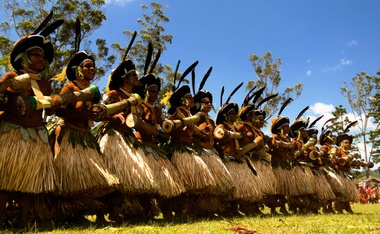The views expressed in our content reflect individual perspectives and do not represent the authoritative views of the Baha'i Faith.
The Baha’i teachings, as explained here in a 1988 message written on behalf of the Universal House of Justice, urge everyone to recognize that revelation and spirituality belong to all human beings.
This respect for the religious and spiritual traditions of all Indigenous peoples comes directly from:
… the Baha’i concepts, as expressed by Abdu’l-Baha, namely that the fountainhead of all religions is to be found in God through the Teachings of His Prophets, and that all peoples have drunk at this ocean of divine Revelation ….
The Baha’i attitude to earlier religions, therefore, is not that they are false or “heathen”, but that, at root, they are all true and that these fundamental truths still persist within them. Baha’is encourage Indians in South America, for example, to see and reverence the profound spiritual truths which are to be found in both their pre-Christian religions and in the Catholicism which, in later centuries, has to varying degrees supplanted or overlaid their archaic faiths. Through the Baha’i teachings, the inner conflict which many still feel between their ancient religions and Christianity is resolved and, at the same time, they are enabled to understand their spiritual unity with the peoples of other continents, such as Buddhists, Hindus and Muslims with whom they will undoubtedly come into contact with increasing frequency.
An example of the Baha’i attitude is to be found in the operation of such radio stations as Radio Baha’i Ecuador, which has a policy of encouraging Indian arts and music and fostering in the Indians pride in their heritage. – https://bahai-library.com/compilation_cultural_diversity_maturity.
Q: In the previous article, we explored the spiritual traditions of the Nalik peoples of Papua New Guinea with Professor Craig Volker – who has also been honored by being named a Wangpaang – an Associate Talking Chief, an honorary chiefly title in Nalik society. In this installment we’ll ask Craig about another Indigenous tradition from the Maprik peoples, who practice the teachings of an historic messenger known as the Yam Prophet. Craig, welcome back! In our earlier correspondence, you explained:
Papua New Guinean cultures are incredibly diverse, and I cannot pretend to be really knowledgeable about any other than the Nalik culture, where my home is. But I would say that the only place where I have heard mention of a specific individual was in the Maprik area of the East Sepik Province, where I lived for two years in the 1980s, just as the area was opened up to Baha’i teachings. People in the Maprik area stand out physically because they look healthier and stronger than their neighbors. This was explained to me by the fact that they had been following the teachings of the “Yam Prophet,” who had brought a new way of life some centuries ago. He stopped tribal fighting by replacing warfare with contests to see who could grow the biggest yams. These yams also replaced the staple food in the Sepik region, which is sago. In contrast to yams, sago has few nutrients and almost no protein. It’s basically just a stomach filler so that elsewhere in the Sepik there is a lot of undernourishment. You even see children with swollen stomachs, something that is exceptionally rare otherwise in Papua New Guinea.
RELATED: Patricia Locke on Native American Manifestations of God
Maprik people credit the Yam Prophet with stopping warfare and improving nutrition by using spiritual teachings. They mentioned this when learning about the Baha’i Faith, and I replied that this was proof that God has spoken in many ways to all people. That was back in the 1980s.
Q: So Craig, please tell us – how did you first learn about the Yam Prophet?
A: I was teaching at a boarding high school on the coast of East Sepik Province and was traveling to the interior Maprik region of East Sepik Province where the Baha’i Faith had just been introduced. People showed me the huge yams they were growing for competitions at a Yam Festival. When I asked about the reason for the enormous yams they were growing, they told me about the Yam prophet, and we talked a bit about how God has given every people messengers.
Q: Did the Yam Prophet bring any ethical teachings that you know of?
A: The one teaching they stressed was no more warfare, using yam competitions instead to deal with rivalries between clans. I am not aware of any other teachings, but undoubtedly there were others.
Q: How can we find out more?
A: Now there is a quite strong Baha’i community in the Maprik area, with families extending into the second and third generations, so perhaps contact could be made with people in the Sepik region through the National Baha’i Centre of Papua New Guinea. I know some of the younger generations are quite well educated in English.
The Sepik area has attracted anthropologists for over a century now, so it is quite possible that some have written about it, but I am not well-versed in Sepik anthropology.
The problem in Papua New Guinea is that very few people with a traditional education also have Western education, and few of them publish what they know. This means that most of the published materials come from outsiders, with their own biases and misconceptions. Many people mistrust anthropologists, some with good cause, but some because of a misunderstanding of what anthropologists try to do and what their motives are.
In many areas, knowledge is not for public consumption. In my own village in New Ireland the majority of maimais are Baha’is, and they have embraced the Baha’i appreciation of science and the role of public education, so they are very open for much (but not all) traditional knowledge to be published and shared with outsiders. They have always encouraged me to publish and, indeed, even maimais who are not Baha’is take pride in the fact that their culture is shared with others. One of my neighbors put this into a song of praise for Baha’u’llah with one part that translates as, “Thank you Baha’u’llah, for now because of you we know the world and the world knows us.”
Q: Thanks, Craig. This is fascinating. In my own search for the Yam Prophet, I came across much good information about the yam festivals you mentioned. For example:
Maprik region is the gateway to the famous Sepik River, and the home to Abelam people renowned for their yam cult. The Abelam cultivate two types of yams – the yams used as daily food and gigantic yams, up to 3-4 meters long, used for ceremonies. These long yams are only grown by men in the ceremonial yam gardens, where no women are allowed. As a man’s status and prestige in the community are judged by his ability to grow ceremonial yams, the men compete between themselves for their yam.
Yam cult begins with a ceremony called “blowing on the yams” and finishes with the ceremonial exchange of yams. Yam exchange partners from other villages symbolically “breathe life” into the planting yams to ensure a successful harvest. After this ceremony, the men observe a series of taboos such as taboos against certain food. …
During the 5-month growing season, a man spends all his time in the gardens taking care of yams and performing special rituals to encourage the yams’ growth, out of sight of women and uninitiated boys. It is believed that yams require tranquillity and possess a spirit that could sense any strong emotions. As such, conflicts, fighting and hunting are prohibited during the yam growing season.
Long yams are not intended for personal consumption but for ceremonial yam exchanges. Abelam men grow long yams in strong competition with their long-term partners from neighbouring villages. At the yam ceremony, they give their longest yams to their exchange partners who strive to grow longer yams next time. Although yam exchanges are very competitive, often leading to confrontations, they foster strong ties between villages and facilitate the proliferation of best breeding yams throughout the Abelam land. – “Maprik Tribes: East Sepik Province of Papua New Guinea,” https://anywayinaway.com/photography/papua-new-guinea/maprik-tribes/
Here, the statement that “fighting and hunting are prohibited during the yam growing season” appears to corroborate what you were told about the teachings and legacy of the Yam Prophet of Papua New Guinea.
RELATED: Does Progressive Revelation Include Indigenous Messengers of God?
A: Keep in mind that the word “tribe” is a concept and term used more by outsiders than locals.
Q: Thanks for pointing that out, Craig. We’ll keep searching for more information on sacred traditions regarding the Yam Prophet of the Maprik people. More importantly, you have offered our readers key observations as to the importance of “Indigenization of the Baha’i Faith,” from the Baha’i experience in Papua New Guinea. This is all the more significant as you are speaking not only as a scholar, but as an appointed and not merely honorary “Associate Talking Chief” (Wangpaang), in Nalik, Papua New Guinea.
We’ll close our brief visit to the peoples of Papua New Guinea with this apt quotation by Abdu’l-Baha, from a speech he gave in Chicago in 1912:
… peace and amity, which God has willed for His children, are the saving factors of human society, whereas war and strife, which violate His ordinances, are the cause of death and destruction. Therefore, God has sent His Prophets to announce the message of goodwill, peace and life to the world of mankind.

















Comments
Sign in or create an account
Continue with Googleor